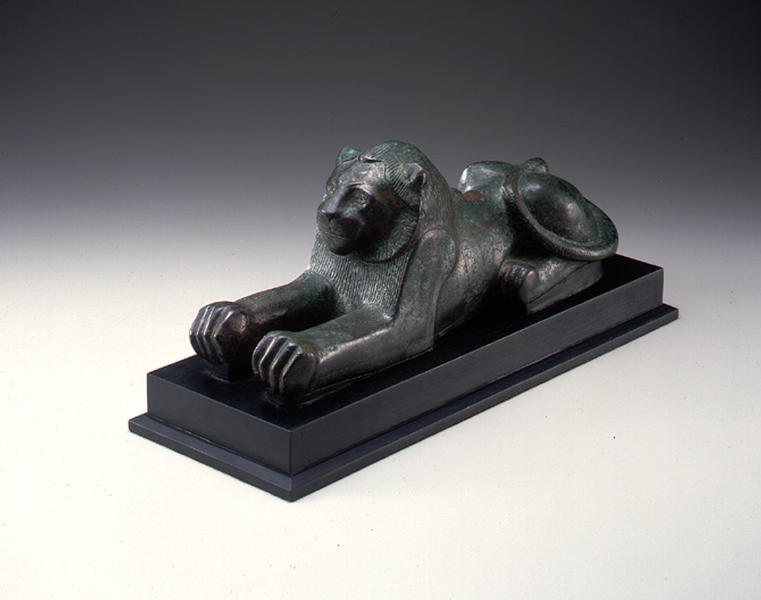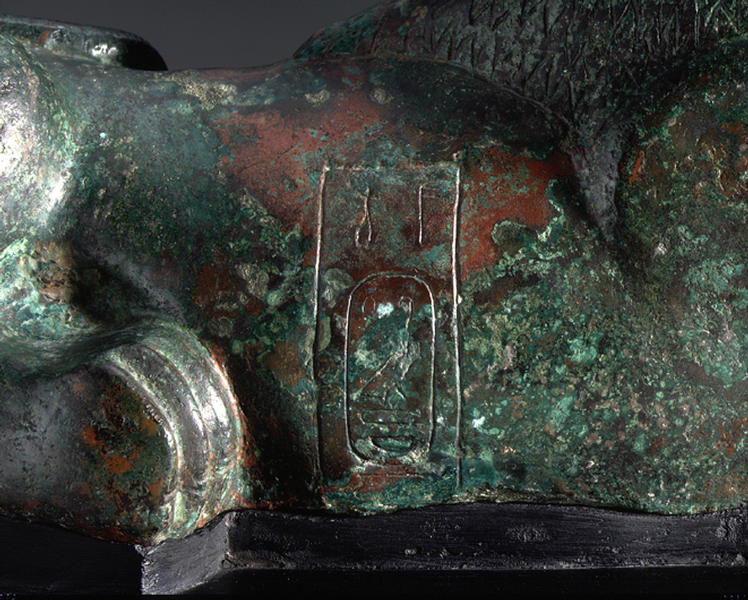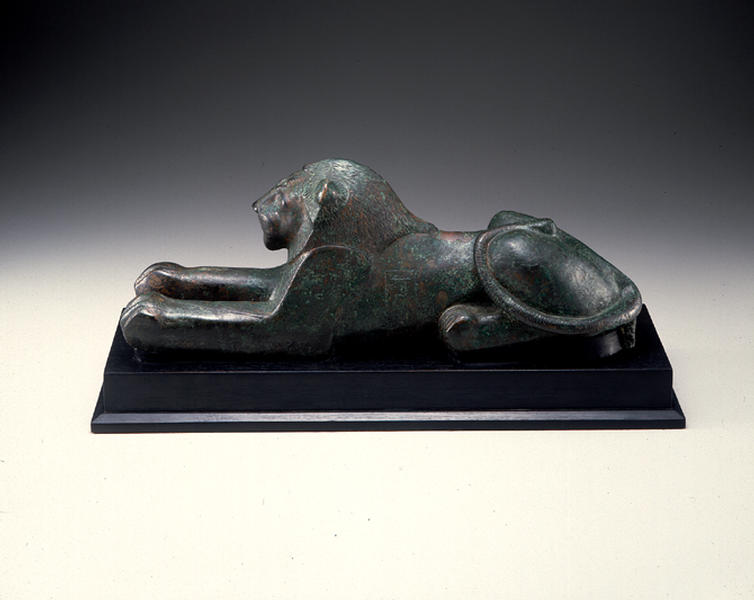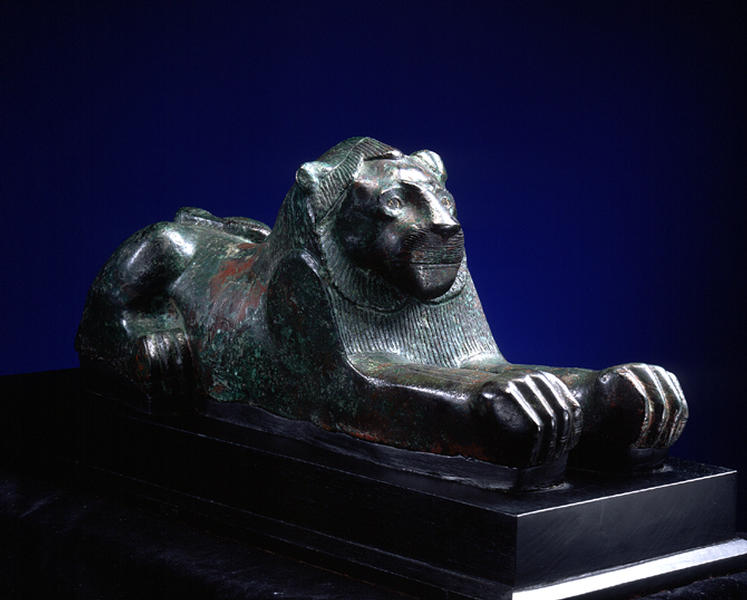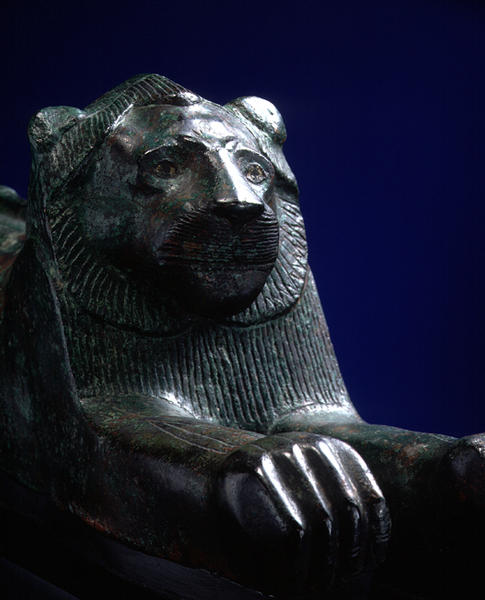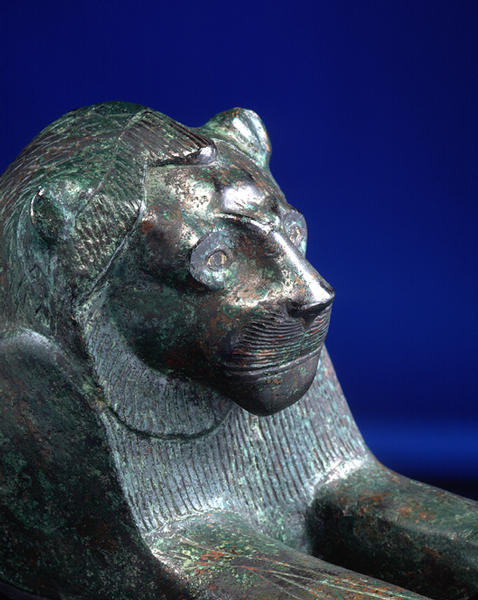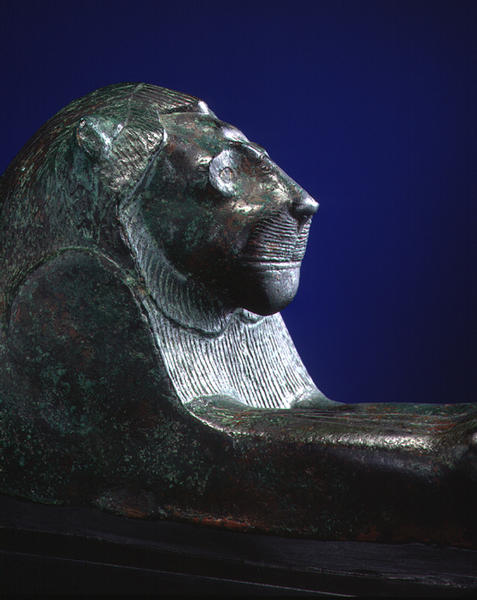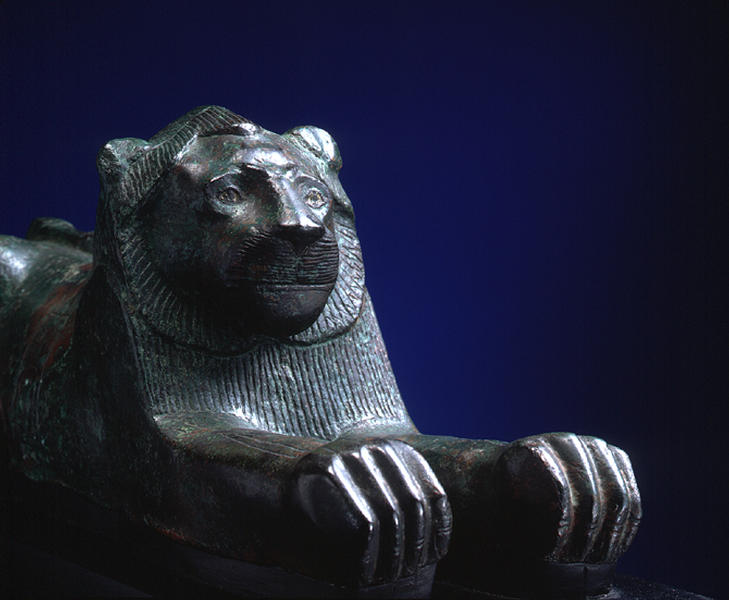ライオン像
- エジプト新王国時代
- 7-6cB.C.
- 青銅、金
- H-16 D-48
解説(開館1周年記念展)
この青銅の横たわるライオン像は前脚を水平に真っすぐ伸ばし尻尾を左臀部に巻き上げた,古来のエジプト美術に典型的な体勢をとっている。両前脚の付け根の間と尻尾の付け根の下から5センチ程の台座に取り付けるための■が下方に突出しているが,蝋型法で鋳造する時に青銅の注口となったものであろう。像壁の厚みは5ミリから16ミリとかなりの厚薄のばらつきが見られる。眼窩と眼の表現は平面的で,白眼には金の象嵌が見られる。鋳造後に鑿で刻まれた表面の意匠は幾分簡略化されている。たてがみの前面から胸元の部分は,やや傾斜した平面に作られ,先端の尖った髪の房を表す単純な文様が繰り返され顔面の周囲を巡り,同様のやや短い組み合わせで背中に広がるたてがみ全体が覆われている。口髭は逆三角形の鼻の下に刻まれた単純な平行線で表されている。これらは新王国頃の石像セクメト神や王の顔面をもつスフィンクスなどに見られる意匠を,簡潔化した表現と考えられる。
胴体右側面には矩形の枠内に,腐食が激しいが,カルトゥーシュに囲まれた第26王朝プサメティク王の王名が読みとれる。左側面には,更に腐食が激しいが,同様に矩形の枠に囲まれ「Asar」と読まれる2文字のヒエログリフ,すなわちオシリスを表す言葉が判読できる。これは,この種の青銅像に多く見られる「オシリスは○○に生命を与え(たまわんことを)……」という常套句に相当するのではないかと想像される。*1
第26王朝は第25王朝のアッシリア,カッシートの支配から脱し,文化的にも復古の気運が高まった時代に相当する。彼らは古王国や新王国時代の遺物から学び,独自の創造活動を行った。永遠の生命を求める人々はこの像に見られるような奉納像を,自身の名前を刻み神殿の奉献の間に納めた。やがてこれらの奉納物が神殿の奉献の間にあふれると,それらは神殿境内の特別な場所に埋蔵されたのである。*2
これとほぼ同形のライオン像(像壁の厚み約11ミリ,長さ34センチ)がレオントポリスの神殿境内から発掘され,現在ボーデ・ベルリン国立博物館に所蔵されている。*3
1 Gunther Roeder/A¨gyptische Bronzefiguren/Berlin 1956
2 Dieter Arnold/Die Tempel A¨gyptens/Zurich 1992
3 Gunther Roeder/1956 ibid., 477 i) Berlin 8962
Catalogue Entry
This bronze figure of a lying lion stretches its forelegs out horizontally and coils up its tail over the left hip in a typical lying posture of ancient Egyptian art. Two tenons, each about 5cm long, protrude from the underside, one from between the two joints of the forelegs and the other from the pelvic area; these were used to attach the figure securely to the base. They might have served as ports through which molten bronze was poured in the lost-wax casting process. The thickness of the figure varies widely from 5mm to 16mm. The eyeholes and the eyes are set flat into the figure, with the whites of the eyes inlaid with gold. A simple design is chiseled on the surface after casting. The front part of the animal's mane and the chest share the same sloping plane. A simple pattern representing pointed tufts of the lion's mane is repeated around the face, and a shorter combination of the same pattern covers the back of the animal. Under the inverted triangle that represents the nostrils, simple parallel lines are cut for the whiskers. These design elements are considered to be a simplification of the designs seen on stone statues of Sekhmet and sphinxes with kings' faces produced in the New Kingdom era.
In a rectangular frame found on the right side of the body, the name King Psamtik of the 26th dynasty can be found, enclosed in a cartouche, although it is severely eroded. On the left side, even more severely eroded, two hieroglyphs for the pronunciation asar, referring to Osiris, can be made out in a similar rectangular frame. It is speculated that this is a part of an often used expression found on bronze statues of this type "May Osiris give life to...."*1
Egypt during the 26th dynasty repelled foreign powers Assyria and Kushite and exhibited a growing interest in cultural restoration. The people in this period learned a great deal from what remained from the Old Kingdom and the New Kingdom and engaged themselves in their own creative activities. Egyptians who sought eternal life had their names carved on a figure like this and dedicated it to the tribute room of a temple. When the room became filled with them, these objects were moved to a special place in the temple compound and buried there.*2
A bronze figure of a lion almost identical in style (34cm in length and 11mm in thickness) has been excavated from the temple compound in Leontopolis. It is owned by the Bode Berlin National Museum.*3
